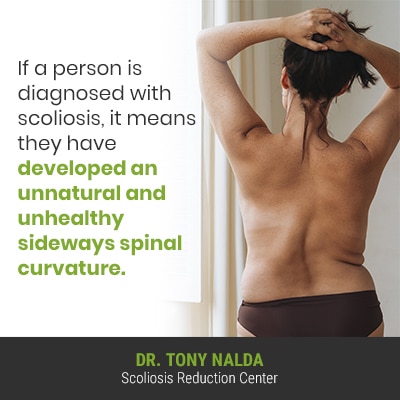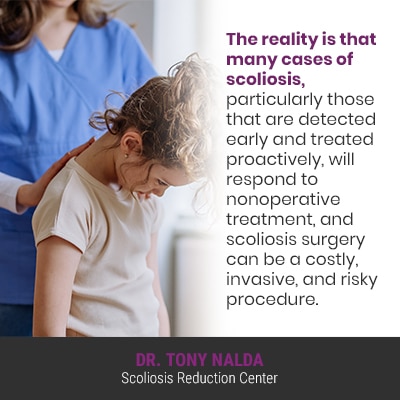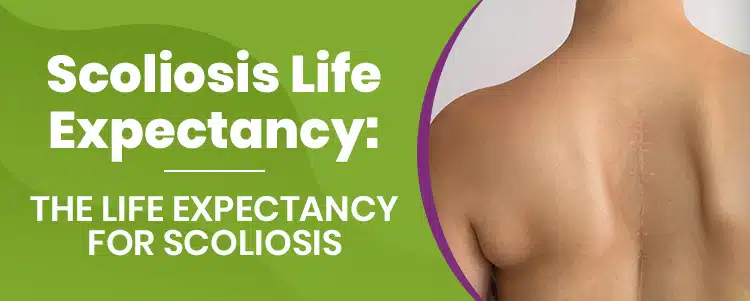Scoliosis life expectancy is a difficult topic to explore because not only does scoliosis range widely in severity, there are also multiple types of scoliosis, some more severe than others. In general, people with scoliosis can still thrive, especially if treated proactively and effectively. Although scoliosis is progressive, it is highly treatable.
When it comes to scoliosis life expectancy, to be clear, scoliosis isn’t a life threatening condition on its own, especially if treated proactively. If severe and left untreated, it can lead to complications that can impact quality of life and life expectancy, but each case is unique.
Before exploring some different scoliosis life-expectancy related factors, let’s first define the condition for a better understanding of what’s happening inside the body of a person recently diagnosed.
Being Diagnosed with Scoliosis

If a person is diagnosed with scoliosis, it means they have developed an unnatural and unhealthy sideways spinal curvature.
I say unnatural because the spine is naturally curved, and its healthy curves are key to maintaining optimal spinal health and function.
The spine’s natural curves make it more flexible so we can engage in a wide range of motion such as bending, twisting, and turning; they also make the spine stronger and more able to evenly distribute mechanical stress incurred during activity.
If the spine loses one or more of its healthy curves, it won’t be able to function optimally, and if left untreated, it can lead to complications.
A scoliotic curve doesn’t just bend unnaturally, it also twists, making scoliosis a complex 3-dimensional condition.
As the spine is such an integral structure of anatomy, if it develops an unnatural curve, its biomechanics are disrupted, and this introduces a lot of uneven forces, not just to the spine, but also its surroundings and the entire body.
In the context of life expectancy, the progressive nature of scoliosis is a key factor because the condition’s very nature is to get worse over time.
Scoliosis is progressive
Scoliosis being progressive means the unnatural spinal curve will increase in size over time, but the rate of a progression is difficult to predict and is case-specific.
The progressive line of scoliosis reflects the condition’s severity levels, and this is determined by a measurement known as Cobb angle.
A patient’s Cobb angle is taken during X-ray and tells me how far out of alignment the spine is.
The spine consists of vertebrae (bones) that are stacked on top of one another in a straight and neutral alignment, but with the development of an unnatural curve, some vertebrae become tilted, shifting the spine out of alignment.
Cobb angle also classifies conditions in terms of severity:
- Mild scoliosis: Cobb angle measurement of between 10 and 25 degrees
- Moderate scoliosis: Cobb angle measurement of between 25 and 40 degrees
- Severe scoliosis: Cobb angle measurement of 40+ degrees
- Very-severe scoliosis: Cobb angle measurement of 80+ degrees
So where a person’s scoliosis is at the time of diagnosis isn’t necessarily indicative of where it will stay, which is why proactive treatment is key to preventing progression and increasing the risk of complications.
Progression and Complications
The more severe a condition, and the longer it’s left untreated, the more likely it is to develop complications such as lung impairment and digestive issues that can affect quality of life and life expectancy, but this is also more related to the actual complications from leaving the condition untreated, than the condition itself.
In addition, even in severe cases, issues like lung impairment tend to be only noticeable to those who place higher-than-average demands on their respiratory systems, such as professional athletes.
While there are never treatment guarantees, especially with early detection and proactive treatment, there are fewer limits to what can be achieved.
Now, when it comes to progression, in the condition’s most-prevalent type, idiopathic scoliosis, we don’t fully understand what causes its onset, but we do know how to treat it, and we do know that it’s growth and development that triggers progression.
So now that we’ve touched on some defining condition characteristics and understand how a diagnosis of scoliosis is reached, let’s address condition type as this is another factor affecting scoliosis life expectancy.
Different Types of Scoliosis
The most common type of scoliosis is adolescent idiopathic scoliosis (AIS) diagnosed between the ages of 10 and 18.
Idiopathic means we don’t fully understand what triggers the codniton’s onset, but we do know how to treat it, and we understand its progressive nature.
Idiopathic scoliosis is also the most common type to affect adults, and these are cases of AIS that went undiagnosed and untreated during adolescence, progressing into adulthood when the condition’s symptoms become more overt, leading to a diagnosis.
Idiopathic scoliosis accounts for approximately 80 percent of known diagnosed scoliosis cases, and the remaining 20 percent consists of types associated with known causes: neuromuscular scoliosis, degenerative scoliosis, and congenital scoliosis.
Neuromuscular Scoliosis
Neuromuscular Scoliosis (NMS) can be severe as it’s caused by an underlying neuromuscular condition such as muscular dystrophy, cerebral palsy, and spina bifida, to name a few.
In these instances, there is a disconnect between the brain, the muscles and/or connective tissues that support the spine.
I can’t offer my neuromuscular scoliosis patients the same prognosis as I can with typical cases of scoliosis because the underlying neuromuscular condition has to be the focus of treatment because it’s caused the scoliosis.
In addition, neuromuscular scoliosis can cause patients to become nonambulatory (unable to walk on their own and wheelchair bound); these cases can become severe quickly and are more likely to have lower life expectancy.
Degenerative Scoliosis
After idiopathic scoliosis, degenerative scoliosis is the most common type to affect adults, and this is caused by natural age-related spinal degeneration that most commonly affects the spine’s intervertebral discs first.
In cases of degenerative scoliosis, these patients are older as spinal degeneration tends to affect adults over the age of 40.
Degenerative scoliosis is also more common in women, and this is related to changes in bone density and hormones related to menopause.
Congenital Scoliosis
Congenital scoliosis is a rare form, affecting approximately 1 in 10,000; this type is caused by a malformation within the spine itself that develops in utero, so infants are born with the condition.
So as you can see, clear-cut answers are not always easy to reach when it comes to questions regarding spinal conditions as complex as scoliosis; not only does the condition affect all ages, it’s progressive, ranges widely in severity, and there are also different types that can develop.
There are many factors that affect the life expectancy for people with scoliosis, and not only are condition factors key, how a diagnosis of scoliosis is responded to in terms of treatment is just as important a factor.
Remember, on its own, scoliosis is not considered a life-threatening condition, and especially when caught early and responded to with proactive treatment, it is highly treatable, allowing many patients to thrive, despite having a structural spinal condition like scoliosis.
Now that we’ve addressed some of the key patient/condition factors that affect life-expectancy rates, let’s take a close look at scoliosis life expectancy.
What is the Life Expectancy of Someone with Scoliosis?
There have been a number of studies done that examine the life expectancy rates of people with scoliosis, especially scoliosis patients who have undergone traditional surgical scoliosis treatment.
According to a study done by the Scoliosis Research Society exploring the mortality rates of scoliosis patients, of various ages and of various condition types, following surgical treatment, it can be difficult to determine accurate life expectancy rates due to inconsistent reporting requirements.
The general conclusion is that the rate of complications in scoliosis surgery is high but varies significantly based on key factors such as patient age, condition severity, and condition type, and surgery type.
From the Scoliosis Research Society’s 2016 mortality report, the results are as follows:
- The average mortality rate for adolescent idiopathic scoliosis surgery in children under the age of 10 is approximately 0.06 percent
- The average mortality rate for adolescent idiopathic scoliosis surgery in children ages 10 to 18 years is approximately 0.02 percent
- The average mortality rate for idiopathic scoliosis surgery in adults is approximately 0.13 percent
- The average mortality rate for neuromuscular scoliosis surgery is approximately 0.26 percent
- The average mortality rate for congenital scoliosis surgery is approximately 0.13 percent
- The average mortality rate for other scoliosis surgery is approximately 0.23 percent
Another study exploring the long-term outcome for adolescent idiopathic scoliosis patients with mild to moderate scoliosis undergoing nonoperative treatment demonstrated positive clinical outcomes.

The reality is that many cases of scoliosis, particularly those that are detected early and treated proactively, will respond to nonoperative treatment, and scoliosis surgery can be a costly, invasive, and risky procedure.
Conclusion
Scoliosis is a highly-prevalent progressive spinal condition that involves a loss of the spine’s healthy curves.
Scoliosis is the leading spinal condition amongst school-aged children, with adolescent idiopathic scoliosis being the most prevalent condition type.
When a person is first diagnosed with scoliosis, it’s only natural to ask whether or not that condition is life threatening, and while there are never guarantees, scoliosis can be highly treatable, and surgery is not the only response.
The type of conservative chiropractic-centered treatment that I offer patients of the Scoliosis Reduction Center® has results that speak for themselves.
For those concerned about the life expectancy rates of people with scoliosis, the more severe the condition, the more likely it is to cause severe symptoms that can indirectly affect a person’s life expectancy, but for those that opt for proactive treatment, those rates can decrease significantly.




